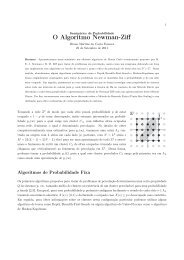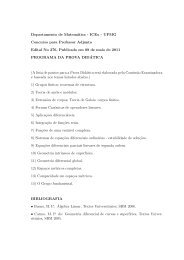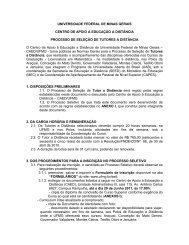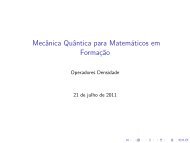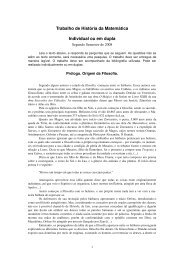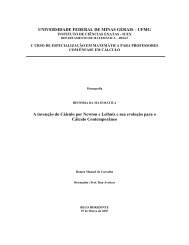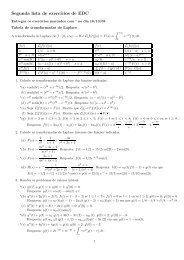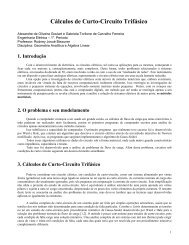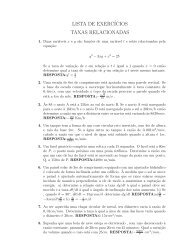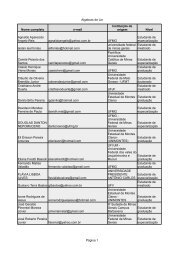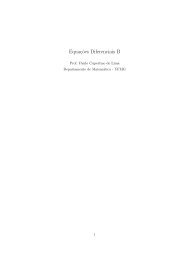Autovalores do Laplaciano - Departamento de Matemática - UFMG
Autovalores do Laplaciano - Departamento de Matemática - UFMG
Autovalores do Laplaciano - Departamento de Matemática - UFMG
You also want an ePaper? Increase the reach of your titles
YUMPU automatically turns print PDFs into web optimized ePapers that Google loves.
Rodney Josué Biezuner 21<br />
<strong>do</strong>n<strong>de</strong> concluímos que (∇um) é uma seqüência <strong>de</strong> Cauchy em L 2 (Ω). Pela <strong>de</strong>sigualda<strong>de</strong> <strong>de</strong> Poincaré temos<br />
que<br />
uk − ul L 2 (Ω) C ∇uk − ∇ul L 2 (Ω) ,<br />
logo (um) também é uma seqüência <strong>de</strong> Cauchy em L2 (Ω) e portanto (um) é uma seqüência <strong>de</strong> Cauchy em<br />
W 1,2<br />
0 (Ω), ou seja, existe u ∈ W 1,2<br />
0 (Ω) tal que um → u em W 1,2<br />
0 (Ω). Em particular, segue que I (u) = I0.<br />
Como um → u em L2 (Ω) e ∇um → ∇u em L2 (Ω), temos que<br />
<br />
1<br />
|∇um|<br />
2 Ω<br />
2 <br />
dx + fum →<br />
Ω<br />
1<br />
<br />
|∇u|<br />
2 Ω<br />
2 <br />
dx + fu,<br />
Ω<br />
e concluímos que u é o minimiza<strong>do</strong>r <strong>do</strong> funcional <strong>de</strong> Dirichlet I. <br />
Se a fronteira e os da<strong>do</strong>s <strong>do</strong> problema são suficientemente regulares, po<strong>de</strong>-se provar que uma solução<br />
fraca é uma solução clássica (veja [Gilbarg-Trudinger] ou [Biezuner] para os <strong>de</strong>talhes):<br />
1.12 Teorema. Seja Ω ⊂ R n um aberto limita<strong>do</strong> com fronteira <strong>de</strong> classe C ∞ . Seja f ∈ C ∞ (Ω).. Se<br />
u ∈ W 1,2<br />
0 (Ω) é uma solução fraca <strong>de</strong><br />
∆u = f em Ω,<br />
então u ∈ C ∞ Ω .<br />
1.7 O Espectro <strong>do</strong> <strong>Laplaciano</strong><br />
u = 0 sobre ∂Ω,<br />
1.7.1 Existência e Caracterização Variacional <strong>do</strong>s <strong>Autovalores</strong> <strong>do</strong> <strong>Laplaciano</strong><br />
Para o problema <strong>de</strong> Dirichlet, o espaço natural para aplicar o méto<strong>do</strong> variacional é W 1,2<br />
0 (Ω), enquanto que<br />
para o problema <strong>de</strong> Neumann trabalharemos em W 1,2 (Ω). Examinaremos primeiro o problema <strong>de</strong> autovalor<br />
<strong>do</strong> laplaciano para condição <strong>de</strong> fronteira <strong>de</strong> Dirichlet.<br />
Definição. Dizemos que u ∈ W 1,2<br />
0 (Ω) é uma solução fraca para o problema <strong>de</strong> autovalor <strong>do</strong> laplaciano<br />
para condição <strong>de</strong> fronteira <strong>de</strong> Dirichlet<br />
−∆u = λu em Ω,<br />
se <br />
<br />
∇u · ∇v = λ<br />
Ω<br />
u = 0 sobre ∂Ω,<br />
Aceitaremos o seguinte resulta<strong>do</strong> <strong>de</strong> regularida<strong>de</strong> sem <strong>de</strong>monstração.<br />
Ω<br />
uv para to<strong>do</strong> v ∈ W 1,2<br />
0 (Ω) . (1.17)<br />
1.13 Teorema. Seja Ω ⊂ R n um aberto limita<strong>do</strong> com fronteira <strong>de</strong> classe C ∞ . Seja λ ∈ R. Se u ∈ W 1,2<br />
0 (Ω)<br />
é uma solução fraca <strong>de</strong> −∆u = λu em Ω,<br />
então u ∈ C ∞ Ω .<br />
u = 0 sobre ∂Ω,<br />
1.14 Teorema. Seja Ω ⊂ R n um aberto limita<strong>do</strong>. Então o problema <strong>de</strong> autovalor<br />
−∆u = λu em Ω, u ∈ W 1,2<br />
0 (Ω)<br />
possui um número infinito enumerável <strong>de</strong> autovalores<br />
0 < λ1 λ2 . . . λj . . .




